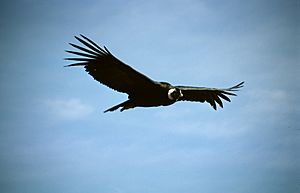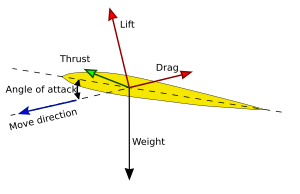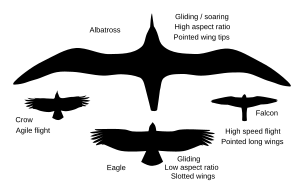Bird flight facts for kids

Flight is how birds, insects, and even some machines move through the air. Birds are amazing flyers! They use their special wings, which have light, hollow bones and strong feathers. Birds also have a smooth, streamlined body shape. This helps them cut through the air easily, like a fast boat through water.
Birds can move in different ways. Some flap their wings quickly to fly forward. Others can stay in one spot in the air, which is called hovering. A kestrel is a good example of a bird that hovers with very fast wing beats.
Some birds, like buzzards, hardly use any energy to fly. They soar by finding columns of warm, rising air. They ride these air currents up high, then glide down to find another warm air current. This way, they can fly all day long without getting tired!
Birds like hawks and gannets are expert divers. They fly up high, then fold their wings and dive head-first very fast to catch their prey.
How Birds Get Lift
Have you ever wondered how birds stay up in the air? It's similar to how airplanes fly! A special force called lift helps them.
What is Lift?
Lift is created by how air moves over a bird's wing. A bird's wing is shaped like an airfoil, which is a special curved shape. As air flows over the wing, it moves faster above the wing and slower below it. This creates lower pressure above the wing and higher pressure below it. The higher pressure underneath pushes the wing (and the bird) upwards, creating lift!
Images for kids
-
The ruby-throated hummingbird can beat its wings 52 times a second.
-
A male bufflehead runs atop the water while taking off.
-
A magpie-goose taking off.
-
A kea in flight.
-
The budgerigar's wings, as seen on this pet female, allow it excellent manoeuvrability.
-
A roseate tern uses its low wing loading and high aspect ratio to achieve low speed flight.
-
Black-legged kittiwakes fly at Cape Hay in the High Arctic.
-
It is unknown how well Archaeopteryx could fly, or if it could even fly at all.
See also
 In Spanish: Vuelo de las aves para niños
In Spanish: Vuelo de las aves para niños













